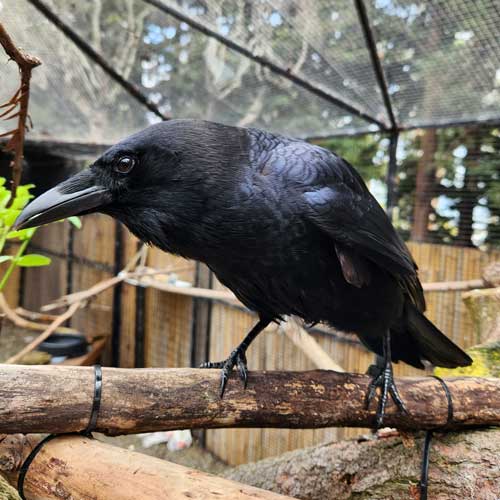ANIMALS
American Crow

This animal can be observed in CuriOdyssey's Garden Aviary.
Latin Name
Corvus brachyrhynchos
American Crow History at CuriOdyssey
Sam was brought to a wildlife rescue center after approaching humans in the wild. The rescue center believes he was likely habituated to humans at an early age and is not considered safely releasable. He was transferred to CuriOdyssey in June 2020 by the Wildlife Care Association. Russell was found in the wild with a left wing fracture in 2008 which required a partial amputation. She lived at the Randall Museum before coming to CuriOdyssey in 2022.
Fun facts about American Crows
Crows are all black in color, even the legs and bills, and their feathers have a glossy slightly iridescent look. In addition to roosting and foraging in numbers, crows often stay together in year-round family groups that consist of the breeding pair and offspring from the past two years. Crows are capable of working together, problem-solving, and being resourceful in their food habits.
American Crows can be distinguished from Common Ravens most easily by size (ravens are much larger), by vocalizations (ravens have a deeper, throatier call), by the bill (ravens have a thicker beak with a slightly bigger curve at the end), and by the shape of the tails in flight (ravens have more of a wedge-shaped tail compared to the fan-shaped tail of crows).
What do American Crows eat?
At CuriOdyssey, we serve our crow fruits, vegetables, feline kibble, whole prey, nuts, crickets, mealworms, and hard-boiled eggs. In the wild, crows consume a wide variety of plant and animal matter, including carrion.
How long do American Crows live?
In the Wild: 6–14 years
In Captivity: 20+ years
Where do American Crows live?
Crows are arboreal, diurnal and omnivorous. They are widely distributed throughout North America. Crows breed from British Columbia to Newfoundland and south to southern California, Florida and the Gulf coast. They winter as far as southern Canada.
Are American Crows endangered?
No special status, although corvids are now protected under the Migratory Bird Treaty Act.
SPONSOR AN ANIMAL
Help provide for the care and feeding of our wildlife guests by sponsoring an animal of your choice for a year.
Join the CuriOdyssey Community
LOCATION
1651 Coyote Point Drive
San Mateo, CA 94401
Ohlone Land Acknowledgement
650-342-7755
info@curiodyssey.org
CuriOdyssey is a 501(c)(3) non-profit, Tax ID 94-1262434

